A Walk Through History
Following World War II, a group of nations were consolidated into what we referred to as Yugoslavia, ruled by a man named Tito. Not owing his ascension to power to the Soviet Union, but still being a communist, he proclaimed that Yugoslavia would go a third way, part of neither the East nor the West. Being in the precarious position of being fully aligned with neither World Power, Tito structured his military to simultaneously repel both the East and the West. This setup resulted in some unique and highly specialized small arms.
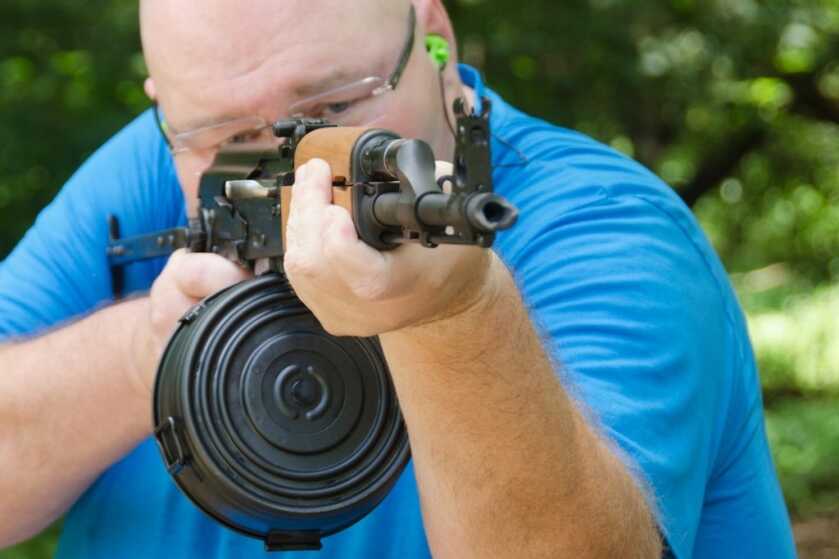 The Yugoslavian military adopted the basic pattern of the Soviet AKM rifle and made some alterations to adapt it to their doctrine. Rifle grenades were thought of as a huge force multiplier by the Yugoslavians, which resulted in several of those modifications. The rifle was equipped with a gas shut off, its trunnion was made wider, and its receiver was fashioned from 1.5 mm. sheet metal rather than 1 mm. This configuration allowed the Yugoslavian AK to fire a steady diet of rifle grenades without coming apart. The Soviets had experimented with under-folding stocks but had quickly abandoned them for a variety of side-folding stocks. The Yugoslavian military, however, adopted the under-folding stocks and issued many them.
The Yugoslavian military adopted the basic pattern of the Soviet AKM rifle and made some alterations to adapt it to their doctrine. Rifle grenades were thought of as a huge force multiplier by the Yugoslavians, which resulted in several of those modifications. The rifle was equipped with a gas shut off, its trunnion was made wider, and its receiver was fashioned from 1.5 mm. sheet metal rather than 1 mm. This configuration allowed the Yugoslavian AK to fire a steady diet of rifle grenades without coming apart. The Soviets had experimented with under-folding stocks but had quickly abandoned them for a variety of side-folding stocks. The Yugoslavian military, however, adopted the under-folding stocks and issued many them.
Century Arms N-PAP DF
Century Arms has struck a deal with Zastava in Croatia (formerly Yugoslavia) to produce the N-PAP DF rifle for them. This is a traditionally-styled Yugoslavian AK variant featuring the under-folding stock, blonde wood and excellent quality. I was thoroughly impressed with the fit and finish of my example rifle. The blued finish on all the metal parts was very nicely done, the gun did not rattle, and every single part was fit tightly, to the point of needing to be loosened up by working them back and forth prior to my first range trip.
The ATF has kindly set up a list of parts that must be American-made for a firearm to be imported. The net output of these restrictions is often just a plethora of sub-standard rifles since many parts are imported and assembled in the United States, rather than the parts being produced and assembled by a single entity. To avoid this quality pitfall, the major components of this rifle are all produced in Croatia, assembled, and then shipped to the United States with the rifle in a non-functioning state. Century then installs the internal fire control systems, slant-cut muzzle brake, and plastic pistol grip, and then adds a Magpul magazine. This process to allows the gun to be completely legal while benefiting from excellent manufacturing processes in Croatia, and an outstanding fire control system not found easily on other rifles.
Century has developed their own fire control system, and I found it to be simply outstanding. When I measured the trigger pull with my Wheeler Engineering digital gauge, it delivered 2.2 pounds on the foot of the trigger and 5 pounds at the top. It broke cleanly and consistently with a short reset.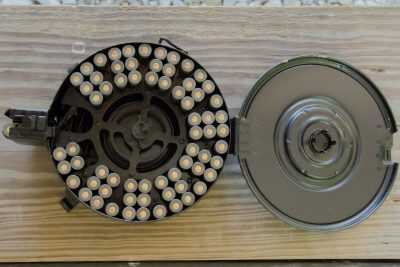
The under-folder was of a traditional Yugoslavian design, constructed of riveted, folded steel that came to a horseshoe-shaped with a push button on the left side of the receiver that allowed it to be under-folded, swiveling around the Magpul magazine. The butt plate on the end pivoted without any buttons to push. I will note that this mechanism required a lot of work to be loosened up before it was serviceable in the field; I’m not complaining, as I’ve seen many of them that will simply flop back and forth.
Another uniquely Yugoslavian feature is the button to remove the top dustcover that is found on the left upper-rear of the receiver. To remove the cover, you simply push the button and then push the guide rod forward. From what I can tell, this is a feature left over from grenade-firing that prevented the dust cover from coming loose during grenade launching.
The front hand guards are both made of wood. As to what type of wood, there’s plenty of speculation on the internet, but nothing definitive. I will note that they were very tight and functional, and presented no issues. However, I believe that I would replace these with a polymer set that would offer some modularity to the front of the gun.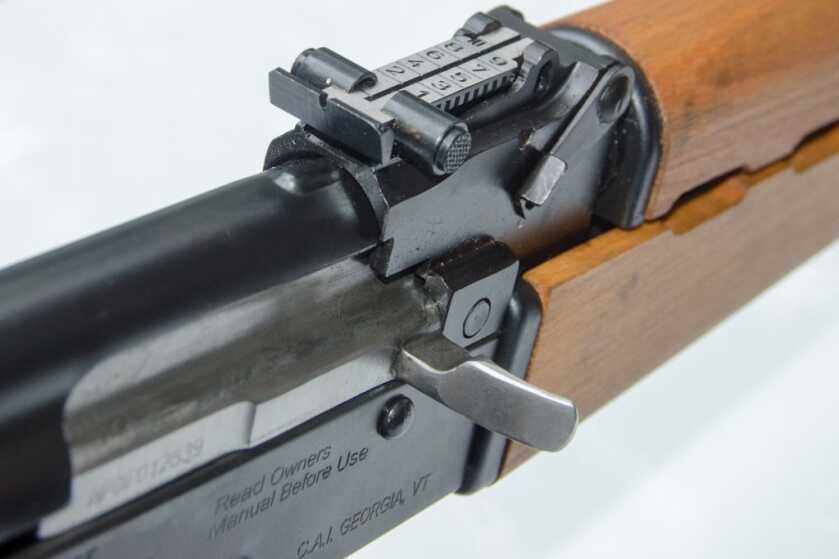
Another feature on this gun is a bolt hold open that has been integrated into the safety selector, allowing for the bolt to be locked to the rear. To engage this, you pull the bolt to the rear while applying upward pressure on the selector lever. The bolt then slips into a notch cut on the selector, locking it open. This can be particularly helpful, as some ranges require locking the bolt back on your gun to transport it or to show clear when going downrange to change targets. There are Yugoslavian magazines available that have a special follower that will hold the bolt open rather than allowing the bolt to close after the last round has been fired. I ran my example gun with a few such magazines and it worked flawlessly.
What’s Relevant?
I find myself scratching my head when I hear a gun person say, “I would never buy that gun because it doesn’t have…” A common one I hear the desire for a chrome-lined barrel. “Why?” instead. The answer is usually something like “Well, that’s what the government guns have!”
I will then offer up that most people agree that chrome-lined barrels sacrifice accuracy and that nitride-treated barrels offered today are considered more accurate and reliable. Sometimes, I will follow that up by suggesting that the practice of chrome-lining the barrel is obsolete anyway, as we have better viable coatings. Chroming the barrel and bolt also allows corrosive ammunition to be used until it was exhausted, so why sacrifice accuracy now in the name of tradition? This usually results in a lot of scuffing of feet in the gravel, and then the subject gets changed.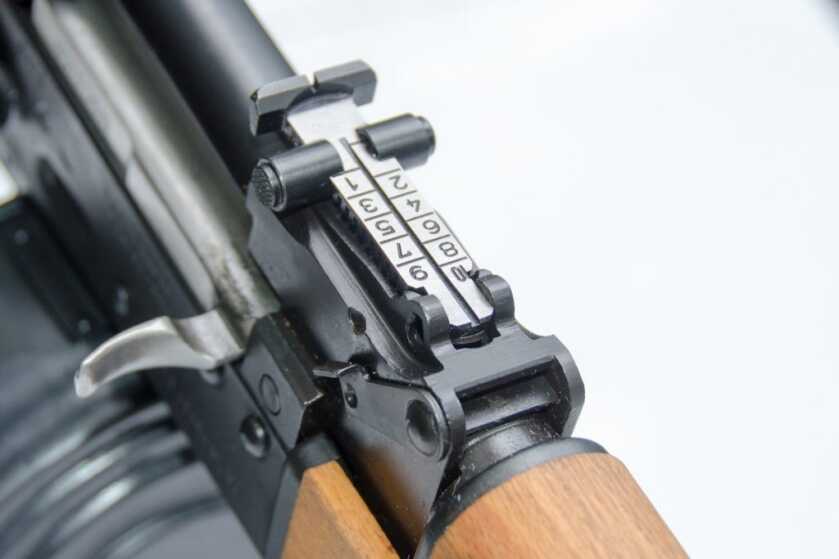
I have brought this up because there are a few such features “missing” from this rifle, that for 99.9 percent of the users would never be of any value anyway. The gas shut off, widened trunnion and thicker sheet-metal on the receiver have not been added to this rifle. The only function that they served was to launch rifle grenades; why would I need that? I’ve never launched a rifle grenade with an AK. However, if you regularly find yourself in situations where you are launching rifle grenades with an AK 47, you probably shouldn’t buy this gun. As a matter of fact, the addition of these features would only serve to add unnecessary weight to the gun, without providing any necessary or improved functionality.
The barrel on the N–PAP is hammer-forged but unlined. This could be an issue if you’re planning on shooting corrosive ammunition. A quick note on corrosive ammunition: The corrosive part of the round is not the powder or projectile, but rather the primer. Cleaning a gun fired with corrosive ammunition is as simple as washing it with hot soapy water and then rinsing it off. Failure to do this can result in corrosion of the barrel, bolt, and chamber. Most ammunition available to us in the United States today is non-corrosive, so this shouldn’t be a deal-breaker. The bolt and bolt carrier are nickel-plated rather than the traditional chrome-plating. This should not present an issue, as the nickel is easy to clean and will resist carbon well.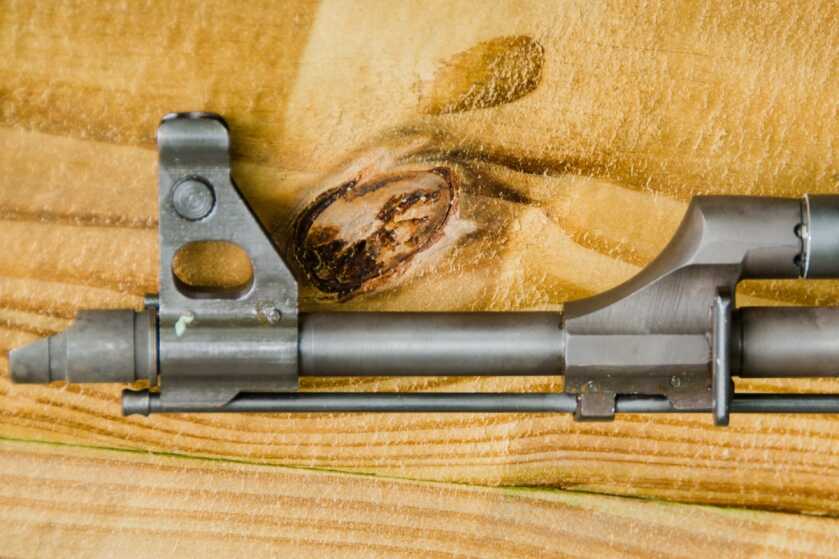
My final admonition here is that the Yugoslavian rifles use some non-standard parts from traditional AKM rifles. The handguards, buttstock, dustcover and gas tube are all unique, so they will not be a simple swap with AKM variance. That being said, aftermarket parts are not difficult to find, as there are plenty of companies manufacturing parts for these Serbian rifles.
In summation: don’t buy corrosive ammunition, clean the dang rifle every once in a while, and try to avoid active military conflict zones because you don’t have a grenade launcher on your AK.
Article Continues Below
SPECS
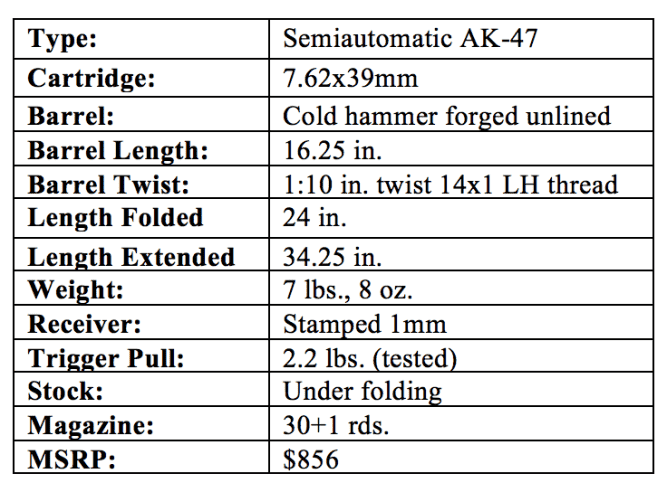
Test Firing
 I loaded up three different types of magazines. In addition to the included Magpul magazine, I ran some Yugoslavian steel and a Romanian 75-round drum. To fill these magazines, I had a quantity of Red Army steel case, American Eagle brass case, and Hornaday steel case ammunition.
I loaded up three different types of magazines. In addition to the included Magpul magazine, I ran some Yugoslavian steel and a Romanian 75-round drum. To fill these magazines, I had a quantity of Red Army steel case, American Eagle brass case, and Hornaday steel case ammunition.
I ran into my first learning curve while loading the 75-round drum; this thing has a manual of arms that, if taken lightly, could probably remove a fingertip. Once I nearly discovered this the “cutty amputate-y” way, I busted out the instruction manual. After about 20 minutes of reading and working, I had 75 rounds of Red Army ammunition locked and loaded. The other two varieties of magazines were straightforward and easy to load.
As I was shooting the gun, I was immediately impressed by how easy it was to control with the Century Arms trigger. I must confess that the under-folding stock was a bit irritating. I traditionally will shoot with electronic earmuffs, and I quickly discovered that the metal arm of the under-folder likes to work itself under the earmuffs and then proceed to push them off my ear. This necessitated swapping out the earmuffs for earplugs. Also, the stock required me to lean more into the gun than normal to see the sights correctly.
While reloading after the third magazine, I noticed that the cleaning rod tended to walk itself loose and begin to charge the target on its own. I solved this problem by simply removing the cleaning rod and putting it in my range bag.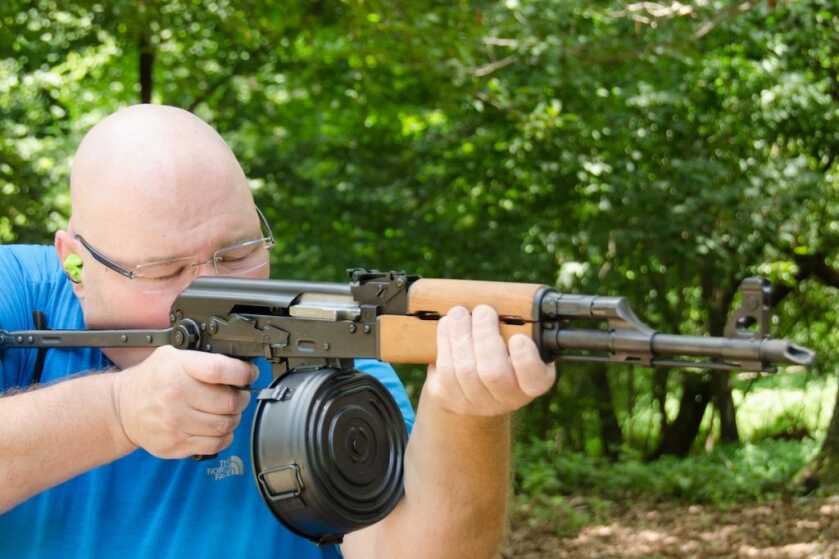
After a few hundred rounds, I was sure that the gun was running consistently, so I decided to heat it up a bit by running the 75-round drum. Two things became evident. First, about half way through the drum, the gun began to smoke from the barrel and gas tube. The wood forearm did an excellent job of keeping the heat from becoming uncomfortable on my hands. The only real issue was that the smoke sometimes made it a little difficult to acquire the front sight. At about 50 rounds, my finger had decided that this was above its pay grade and began to grow fatigued. When the drum was finally exhausted, there was a small cloud of smoke around the front of the gun, which was admittedly pretty cool.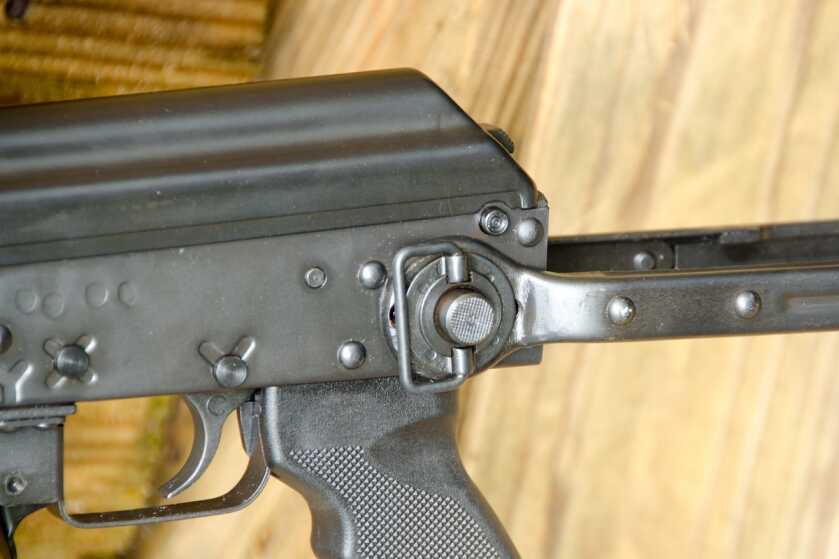
To perform the accuracy testing, I used the Caldwell lead sled and a steel 8-inch target at 100 yards. I put a fresh coat of white paint on the target and settled in behind the gun. No matter which ammunition that was run, and with a variety of shooters behind the trigger, this gun delivered 3 ½ inch groups with decided consistency. I found these results to be quite acceptable for a gun of this class.
There was the obligatory shooting of the gun with the stock folded. The resulting demonstration was one of what I refer to as “turning money into noise,” or maybe just a waste of ammunition. The gun is not actually designed to be fired with the stock folded. This was not a productive activity. Nevertheless, it was fun and necessary.
The Bottom Line
If you’re going to be launching rifle grenades and shooting corrosive ammunition, don’t buy this gun. However, if you’re looking for a Yugoslavian under-folder that is well-made, with a great trigger for a reasonable price this should be on your shopping list.
For more information about Centuy Arms, click here.
To purchase a Century Arms rifle on GunsAmerica, click here.

PROBABLY NOT…
Concerning the barrel, which isn’t chrome lined, it also is NOT treated to any of the newer surface treating processes. I had an N-PAP and found the assembly workmanship to be first class thru out. But when I found out the receiver was only heat treated at the rivet and fire group pin holes I sold it. The no longer available O-PAP is of much higher quality and you can research that fact.
On the subject of corrosive ammunition, I currently have two, 1,260 round cases, of Yugoslavian M67, 7.62X39m/m on hand. I would use this in a older, well used SKS, AK, or VZ-58. This ammunition has been described in the past as “mildly” corrosive. Even though a bore may be chromed lined, the gas piston and the remaining components of the gas system are not. So meticulous cleaning will still be required. For general use the accuracy which may be lost on a chrome lined bore verses one that is unlined would be very negligible in my opinion. Personally, I would much rather have the thicker steel in the receiver even though I really don’t anticipate having to launch any rifle grenades. A bit more tolerances in the moving parts, which may create a mild “rattle”, will also assure the shooter that proper function would most likely be the case under very dirty conditions, especially if the rifle is not cleaned as often as it should be. The weight difference would also very negligible. All in all, I would much rather have another type of under folder. Just my thoughts & opinions.
James
I have it on good authority that the hand guards are hewn from aged Carpathian Gofer wood from the forests of Vlad the Impailer.
I’m a neophyte with only two handguns. Can I buy this and actually learn how to use it? I’ve fallen in love with the Gun.
I do like the chrome lined bore because there is still a lot of corrosive ammo in circulation. It has been my experience that the corrosive stuff will shoot more accurately that the more recent stuff that is not. I like the wood furniture as it will remain cooler for extended shooting. I have remained an avid AK fan because I am willing to give up a few points in accuracy for the reliability, but 4″ groups are a bit much for me to choke down. However, as PGK once commented, “That’s close enough for government work.” The big groups may just be a function of the wretched folding stock, but I would definitely work with it to determine if another type of ammo would shoot a bit better. With an AK, I am looking for 2″ groups. Perhaps I dozed off, but I did not see anything on the loading and use of the 75 round drums . . . Do I need to watch it through again?
I like the 7.62 x 39 round and how common AK-47 magazines are. I hate AK-47 iron sights and how there is no rail to mount optics on it. I like the AR-15 iron sights and how it usually has a picatinny rail to mount optics on but I hate the 5.56 x 45 round.
I have decided on a getting a .300 Blackout AR-15 that I am going to use with supersonic ammunition. Sound suppressors require too much paperwork.
I simply will not purchase an AK that does not feature a chrome lined barrel. I just have too much experience obtaining extremely high fired round counts through rifles that feature high quality chrome lined barrels and still maintain that the SOLE reason the manufacturers went away from chrome lining was because it is MUCH cheaper to provide a barrel that may or may not be “nitride treated” or “melonite treated” and simply do not have the round count as of yet to compare the new (and incredibly cheaper) barrel treatments with the old style chrome lined barrels. AND if chrome lining is solely for protection from corrosive ammo then WHY does our own military insist on their M4’s featuring chrome lined barrels/chambers? It is because chrome lining can meet the ROUND COUNTS REQUIRED DURING TESTING.
My history with chrome lined bores began with an old Polytech Legend that is now too valuable to shoot and went from there to Arsenal Bulgaria rifles and their superb chrome lined barrels onto Arsenal USA and their also SUPERB chrome lined barrels. Does it cost more? Yep. Is it worth it? Yup. Will the gun outlast your grankdids kids after you die and pass em on? Yup. Chrome lining is for MUCH MORE than protection from corrosive ammo.
Please, please help me find a missing part!
I own a Zastava m77ps rifle in .308 and the 3 position gas valve has gone missing. Between my health issues, moving and the passage of time it’s just missing. I’ve exhausted all the possibilities I can imagine. Even calling Century who rudely said (we don’t sell parts) just before briskly hanging up without another word.
Again it is only the chrome plated 3 position gas regulator that I seek. This part is particular to the m77 only. Other weapons with similar part will not work. Any help in locating this part will be so appreciated. Thank you,
Steve in Denver.
I had a n-pap and sold it soon after I bought it. The bulky forearm was a big draw back as was the butt stock, all in all a uncomfortable rifle to shoulder, But within the last 2 years it has come to light that the receirers are not fully heat treated. Rather spot heat treating at the locations of the thru holes for rivets and fire group pins. The result is a weak receiver that does not hold up to long term use.
Try Jack First – he/his company only sells parts. He’s on the internet!
Thanks for your review Jon, as usual you approached this in an extremely professional and detailed manner. Much appreciated!
Was going to mention that these are NOT made in Croatia but in Serbia but Mike beat me to it. I did want to point out that there are NO nickel plated parts on these rifles. The bolt and carrier are “in the white” bare steel and have no finish on them. These are an excellent value for an AK variant.
A quick Wikipedia search gives you some very basic information about Zastava arms that you should have gotten right for this review:
Zastava Arms (Serbian Cyrillic: Застава oружје) is a Serbian manufacturer of firearms and artillery, based in Kragujevac, Serbia. It was founded in 1853 when it cast its first cannons. It is the leading producer of firearms in Serbia and is a large contributor to the local defense industry. Zastava Arms produces and exports a wide variety of products to over forty countries.
Serbia. Not Croatia.
From what I understand, tensions have cooled there enough that the current generations are aimed at reconciliation and mending the divided relationships that their parents generation suffered through during and surrounding the war. But, had you made this mistake even 10 years ago, it would me more than a faux pas, it would have been downright insulting.
Sadly, this aims at the European notion that the “Americans” don’t know anything about the world outside of it’s own borders. And in this case, gun buyers only know enough to relate to the hardware they want to buy, which unfortunately still isn’t saying a lot. Hence your repeated mistake here.
You were right until you said:
“Sadly, this aims at the European notion that the “Americans” don’t know anything about the world outside of it’s own borders. And in this case, gun buyers only know enough to relate to the hardware they want to buy, which unfortunately still isn’t saying a lot. Hence your repeated mistake here.”
First, thanks to uneven and at times tabloidish quality of news reporting worldwide (not just in America), no one worldwide knows anything about the world outside their surroundings. I converse with people from all over the world daily whose grasp of US foreign and domestic policy is either sketchy or very obviously came from news sources with a strong anti-US slant.
Your dismissal of US gun owners is likewise parochial and inaccurate. I find my fellow gun owners to represent a broad range of erudition on the history and present facts surrounding small arms of the world. Wikipedia’s got a strong and well-educated base of gun enthusiasts who maintain informative and accurate articles on any weapon you care to mention, foreign or domestic. US gun owners and enthusiasts are a little more knowledgeable about most weapons than the world average.